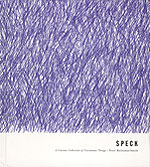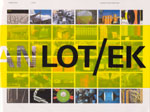Collecting Obsessions | |

| Obsessions are great things. Collections too. I think the two things go pretty much hand in hand. Artists are great obsessives, great collectors. Art, after all, being largely about collecting and collating information about the self and the world, placing the two together in some way or another. Or at least so it seems to me. This is probably why I adore Speck - A Curious Collection of Uncommon Things (Princeton Architectural Press - £17.95). It's a book that does exactly what it says on the cover. In its pages Peter Buchanan-Smith, Art Director of the New York Times' Op-Ed page asks artists, designers, lawyers, writers, collectors and photographers to explore their, and our, obsessions with the details of our everyday lives. So there are collections of things like Mark Ulriksen's array of address labels where his name is misspelled; there are Amy Unikewicz' fantastic garbage letter forms from her 'found alphabet'; there are Stacey Greene's photographs of lipsticks, all curiously formed into a cornucopia of forms in a rich variety of colours. Then there's John Willis' photos of recycled paper, collected in bales at a New England paper mill and Maria Kalman's lists of the contents of people's pocketbooks. Whether there is any accuracy in the list that says the Queen of England had 1 hankie, 1 set of keys and 1 pack of Bendix Bittermints I do now know. I mean, how do you get that kind of information? Bizarre. Bizarre is a word that can be used frequently in respect to Speck, and that's a massive compliment. Wade Shuman's collection of cat whiskers (collected over a twelve year period from a handful of cats that have shared his life and living quarters) is certainly a shade bizarre but also oddly heart-warming, and when the whiskers are arranged in lines for photographs they make for beautiful images, a little like Gillian Ayres paintings. Or what about the Wonder Bread Tests? A contemporary update of the Hansel and Gretel breadcrumb trail, this is Robert Lemons' quirky photo documentary of the fate of slices of bread left as a trail across lower Manhattan and it's a charming exploration of urban space. There's a host of other collections waiting for you in Speck, and they all make for fascinating, addictive reading texts. As an affirmed devotee of the idea that the most important, beautiful things in life are to be found in the details, I love this book unashamedly and unconditionally. I have pored over it for hours, absorbing these odd collections and the obsessions that lurk behind them and wholeheartedly recommend it to anyone with a modicum of interest in the off-centre and the slightly unhinged. Bloody marvellous. |

| Similarly marvellous, and with a similar obsessional character is the LOT/EK: Urban Scan book by Ada Tlla, Giuseppe Lignano and Phillip Nobel (Lawrence King books, £28.00). This is essentially a catalogue of Architectural projects, real and projected, by the New York based firm LOT/EK (pronounced 'low tech'). LOT/EK have developed a terrific process-oriented architectural form that embraces what many would call the detritus of the urban space and modern society. This is real recycled architecture, where petrol tanks, cement mixers, stainless steel sinks et al become sleeping quarters, bathrooms and shelving units in residential and commercial spaces. There's a lot of focus on entertainment environments; great projects like a section of a Boeing 747 fuselage becoming a student lounge/pavilion in Seattle for the University of Washington, or the aluminium tank sliced into individual pieces lined with rubber tubing and cable TV, providing open-ended cells for individual televisual immersion. It's all very '60s. All very Archigram, and all the better for it. The book is more than a record of projects though. It's also a collection of obsessions; a record of looking and of the very essence of recording and the way in which that recording feeds the creative process. So there are pages upon pages, each filled with a 36 image grid showing a myriad of photographs of urban objects like air conditioner units, antennas, appliances, billboards, booths, bridges, lifts, pipes, planes, sheds, tanks, temporary facades and, more than anything else it seems, containers. LOT/EK have a real obsession with containers. There's the photos of course, but there are also amazing proposals for projects involving them, notably the intriguing American Diner #1 and the wonderfully ambitious designs for a Slave Trade Museum on the Manhattan waterfront. LOT/EK are innovative and challenging as architects and designers, and this book is a marvellous record and insight into both their work and their creative process. © Alistair Fitchett 2002 |